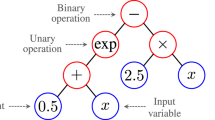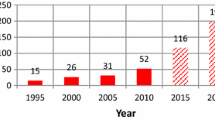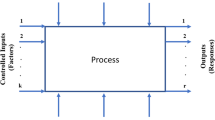Abstract
Building a 3D geological model from field and subsurface data is a typical task in geological studies involving natural resource evaluation and hazard assessment. However, there is quite often a gap between research papers presenting case studies or specific innovations in 3D modeling and the objectives of a typical class in 3D structural modeling, as more and more is implemented at universities. In this paper, we present general procedures and guidelines to effectively build a structural model made of faults and horizons from typical sparse data. Then we describe a typical 3D structural modeling workflow based on triangulated surfaces. Our goal is not to replace software user guides, but to provide key concepts, principles, and procedures to be applied during geomodeling tasks, with a specific focus on quality control.
Similar content being viewed by others
References
Bellian JA, Kerans C, Jennette DD (2005) Digital outcrop models: applications of terrestrial scanning LIDAR technology in stratigraphic modeling. J Sediment Res 75(2):166–176
Bonham-Carter GF (1994) Geographic information systems for geoscientists: modelling with GIS. Computer methods in the geosciences. Pergamon, New York (414 p)
Calcagno P, Chilès JP, Courrioux G, Guillen A (2008) Geological modelling from field data and geological knowledge: Part I. Modelling method coupling 3D potential-field interpolation and geological rules. Phys Earth Planet Inter 171(1–4):147–157
Caumon G, Lepage F, Sword CH, Mallet JL (2004) Building and editing a sealed geological model. Math Geol 36(4):405–424
Caumon G, Tertois AL, Zhang L (2007) Elements for stochastic structural perturbation of stratigraphic models. In: Proc EAGE Petroleum Geostatistics, Cascais (A02)
Chilès JP, Delfiner P (1999) Geostatistics: modeling spatial uncertainty. Series in probability and statistics. Wiley, New York
Chilès JP, Aug C, Guillen A, Lees T (2004) Modelling the geometry of geological units and its uncertainty in 3D from structural data: the potential-field method. In: Dimitrakopoulos R, Ramazan S (eds) Orebody modelling and strategic mine planning, Perth, WA, pp 313–320
Culshaw MG (2005) From concept towards reality: developing the attributed 3D geological model of the shallow subsurface. Q J Eng Geol Hydrogeol 38(3):231–384
Delaunay B (1934) Sur la sphere vide. Bull Acad Sci USSR VII:793–800
de Kemp EA, Sprague KB (2003) Interpretive tools for 3D structural geological modeling part I: Bézier-based curves, ribbons and grip frames. GeoInformatica 7(1):55–71
Dhont D, Luxey P, Chorowicz J (2005) 3-D modeling of geologic maps from surface data. AAPG Bull 89(11):1465–1474
Euler N, Sword CH, Dulac JC (1998) A new tool to seal a 3d earth model: a cut with constraints. In: Proc 68th annual SEG meeting, New Orleans, pp 710–713
Fernández O, Muñoz JA, Arbués P, Falivene O, Marzo M (2004) Three-dimensional reconstruction of geological surfaces: an example of growth strata and turbidite systems from the Ainsa basin (Pyrenees, Spain). AAPG Bull 88(8):1049–1068
Frank T, Tertois AL, Mallet JL (2007) 3D-reconstruction of complex geological interfaces from irregularly distributed and noisy point data. Comput Geosci 33(7):932–943
Gjøystdal H, Reinhardsen JE, Astebøl K (1985) Computer representation of complex three-dimensional geological structures using a new solid modeling technique. Geophys Prospect 33(8):1195–1211
Goovaerts P (1997) Geostatistics for natural resources evaluation. Applied geostatistics. Oxford University Press, New York
Groshong RH (2006) 3-D structural geology, 2nd edn. Springer, Berlin
Haecker MA (1992) Convergent gridding: a new approach to surface reconstruction. Geobyte 7(3):48–53
Holden L, Mostad PF, Nielsen BF, Gjerde J, Townsend C, Ottesen S (2003) Stochastic structural modeling. Math Geol 35(8):899–914
Kaufman O, Martin T (2008) 3D geological modelling from boreholes, cross-sections and geological maps, application over former natural gas storages in coal mines. Comput Geosci 34(3):278–290
Kaven JO, Mazzeo R, Pollard DD (2009) Constraining surface interpolations using elastic plate bending solutions with applications to geologic folding. Math Geosci 41(1):1–14
Lemon AM, Jones NL (2003) Building solid models from boreholes and user-defined cross-sections. Comput Geosci 29:547–555
Maerten L, Maerten F (2006) Chronologic modeling of faulted and fractured reservoirs using geomechanically based restoration; technique and industry applications. AAPG Bull 90(8):1201–1226
Mallet JL (1992) Discrete smooth interpolation in geometric modeling. Comput Aided Des 24:178–191
Mallet JL (1997) Discrete modeling for natural objects. Math Geol 29(2):199–219
Mallet JL (2002) Geomodeling. Applied geostatistics. Oxford University Press, New York
Mallet JL (2004) Space-time mathematical framework for sedimentary geology. Math Geol 36(1):1–32
Mäntylä M (1988) An introduction to solid modeling. Computer Science Press, Rockville
Möller T, Haines E (1999) Real-time rendering. Peters, Natick
Moretti I (2008) Working in complex areas: New restoration workflow based on quality control, 2D and 3D restorations. Mar Petroleum Geol 25(3):205–218
Moyen R, Mallet JL, Frank T, Leflon B, Royer JJ (2004) 3D parameterization of the 3D geological space: the GeoChron model. In: Proc 9th European conference on the mathematics of oil recovery (ECMOR), Nice (A004)
Muron P (2005) Méthodes numériques 3-D de restauration des structures géologiques faillées. PhD thesis, INPL, Nancy, France
Pollard D, Fletcher R (2005) Fundamentals of structural geology. Cambridge University Press, New York
Rouby D, Xiao H, Suppe J (2000) 3-D restoration of complexly folded and faulted surfaces using multiple unfolding mechanisms. AAPG Bull 84(6):805–829
Samson P, Mallet JL (1997) Curvature analysis of triangulated surfaces in structural geology. Math Geol 29(3):391–412
Sprague KB, de Kemp EA (2005) Interpretive tools for 3-D structural geological modelling part II: surface design from sparse spatial data. GeoInformatica 9(1):5–32
Suzuki S, Caumon G, Caers JK (2008) Dynamic data integration for structural modeling: model screening approach using a distance-based model parameterization. Comput Geosci 12(1):105–119
Tarantola A (2006) Popper, Bayes and the inverse problem. Nat Phys 2:492–494
Tertois AL, Mallet JL (2007) Editing faults within tetrahedral volume models in real time. In: Structurally complex reservoirs, geol soc spec pub, vol 292, pp 89–101
Thibault M, Gratier JP, Leger M, Morvan JM (1996) An inverse method for determining three dimensional fault with thread criterion: strike slip and thrust faults. J Struct Geol 18:1127–1138
Thibert B, Gratier JP, Morvan JM (2005) A direct method for modelling and unfolding developable surfaces and its application to the Ventura Basin (California). J Struct Geol 27(2):303–316
Turner AK (1992) Three-dimensional modeling with geoscientific information systems. NATO-ASI math phys sciences, vol 354. Kluwer Academic, Dordrecht
Walsh JJ, Bailey WR, Childs C, Nicol A, Bonson CG (2003) Formation of segmented normal faults: a 3-D perspective. J Struct Geol 25(8):1251–1262
Wycisk P, Hubert T, Gossel W, Neumann C (2009) High-resolution 3D spatial modelling of complex geological structures for an environmental risk assessment of abundant mining and industrial megasites. Comput Geosci 35(1):165–182
Wu Q, Xu H, Zou X (2005) An effective method for 3D geological modeling with multi-source data integration. Comput Geosci 31(1):35–43
Zanchi A, Salvi F, Zanchetta S, Sterlacchini S, Guerra G (2009) 3D reconstruction of complex geological bodies: examples from the Alps. Comput Geosci 35(1):49–69
Author information
Authors and Affiliations
Corresponding author
Electronic Supplementary Material
Rights and permissions
About this article
Cite this article
Caumon, G., Collon-Drouaillet, P., Le Carlier de Veslud, C. et al. Surface-Based 3D Modeling of Geological Structures. Math Geosci 41, 927–945 (2009). https://doi.org/10.1007/s11004-009-9244-2
Received:
Accepted:
Published:
Issue Date:
DOI: https://doi.org/10.1007/s11004-009-9244-2




